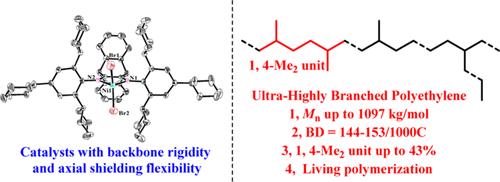Stable Ultrahighly Branched Polyethylene Synthesis via Externally Robust Chain-Walking Polymerization
IF 13.1
1区 化学
Q1 CHEMISTRY, PHYSICAL
引用次数: 0
Abstract
Recently, late-transition-metal-catalyzed chain-walking polymerization has emerged as a promising method for synthesizing a range of polyethylenes, including linear, branched, and hyperbranched structures, solely from ethylene feedstock. The spatial configuration of the catalyst is a crucial factor in determining the branching patterns observed in the resulting polyethylene. In this study, we designed and employed a series of stereoscopically bulky α-diimine Ni(II) and Pd(II) complexes featuring axial flexible cycloalkyl substituents and an equatorial rigid dibenzobarrelene backbone for ethylene (co)polymerization. These Ni(II) complexes exhibited high catalytic activity, reaching up to 106 g/(mol Ni·h), and yielded very-high-molecular-weight polyethylene with extremely narrow molecular weight distributions (1.00–1.27) and very high branching densities (105–153/1000C) in a living ethylene polymerization behavior under various polymerization temperatures. Most interestingly, the branching density of polyethylene from the cyclohexyl-substituted Ni(II) complex is almost independent of the polymerization conditions and ultrahighly branched polyethylene with ultrahigh molecular weight (up to 1097 kg/mol) can be accessed. On the other hand, the corresponding Pd(II) complexes also demonstrated moderate catalytic activity, achieving up to 105 g/(mol Pd·h), and yielded highly branched polyethylene with high molecular weights ranging from 160.8 to 511.9 kg/mol. Moreover, these Pd(II) complexes were capable of generating high-molecular-weight E-MA copolymers with adjustable incorporation ratios (0.85–2.77 mol %) and high branching densities (106–117/1000C). Through a comparative analysis of single-crystal structures and DFT calculations, we found that the axial flexible cycloalkyl substituents and equatorial rigid dibenzobarrelene backbone of these complexes create an interesting ligand environment that favors chain walking over chain propagation in the nickel-catalyzed ethylene polymerization system. This finding provides valuable insights into the design of more efficient and controllable catalysts for the synthesis of polyethylenes with tailored properties.

通过外部稳健走链聚合法合成稳定的超高支链聚乙烯
最近,晚过渡金属催化的链缠绕聚合成为一种很有前途的方法,可以完全利用乙烯原料合成一系列聚乙烯,包括线性、支化和超支化结构。催化剂的空间构型是决定所得聚乙烯支化模式的关键因素。在本研究中,我们设计并使用了一系列具有轴向柔性环烷基取代基和赤道刚性二苯并呋喃骨架的立体大体积 α-二亚胺 Ni(II) 和 Pd(II) 复合物来进行乙烯(共)聚合。这些 Ni(II) 复合物具有很高的催化活性,最高可达 106 g/(mol Ni-h),并且在不同聚合温度下的活乙烯聚合行为中产生了分子量分布极窄(1.00-1.27)和支化密度极高(105-153/1000C)的超高分子量聚乙烯。最有趣的是,环己基取代 Ni(II) 复合物聚乙烯的支化密度几乎不受聚合条件的影响,可以获得超高分子量(高达 1097 kg/mol)的超高支化聚乙烯。另一方面,相应的 Pd(II) 复合物也表现出中等催化活性,催化活性可达 105 g/(mol Pd-h),并可获得高分子量(160.8 至 511.9 kg/mol)的高支化聚乙烯。此外,这些钯(II)配合物还能生成高分子量的 E-MA 共聚物,其掺入比(0.85-2.77 摩尔%)和高支化密度(106-117/1000C)可调。通过对单晶结构和 DFT 计算的比较分析,我们发现这些复合物的轴向柔性环烷基取代基和赤道刚性二苯并环丁烯骨架创造了一种有趣的配体环境,在镍催化的乙烯聚合体系中,这种环境有利于链的行走而不是链的传播。这一发现为设计更高效、更可控的催化剂以合成具有定制特性的聚乙烯提供了宝贵的见解。
本文章由计算机程序翻译,如有差异,请以英文原文为准。
求助全文
约1分钟内获得全文
求助全文
来源期刊

ACS Catalysis
CHEMISTRY, PHYSICAL-
CiteScore
20.80
自引率
6.20%
发文量
1253
审稿时长
1.5 months
期刊介绍:
ACS Catalysis is an esteemed journal that publishes original research in the fields of heterogeneous catalysis, molecular catalysis, and biocatalysis. It offers broad coverage across diverse areas such as life sciences, organometallics and synthesis, photochemistry and electrochemistry, drug discovery and synthesis, materials science, environmental protection, polymer discovery and synthesis, and energy and fuels.
The scope of the journal is to showcase innovative work in various aspects of catalysis. This includes new reactions and novel synthetic approaches utilizing known catalysts, the discovery or modification of new catalysts, elucidation of catalytic mechanisms through cutting-edge investigations, practical enhancements of existing processes, as well as conceptual advances in the field. Contributions to ACS Catalysis can encompass both experimental and theoretical research focused on catalytic molecules, macromolecules, and materials that exhibit catalytic turnover.
 求助内容:
求助内容: 应助结果提醒方式:
应助结果提醒方式:


